New Jersey Future Blog
Launching the Next State Plan
July 18th, 2023 by Zeke Weston
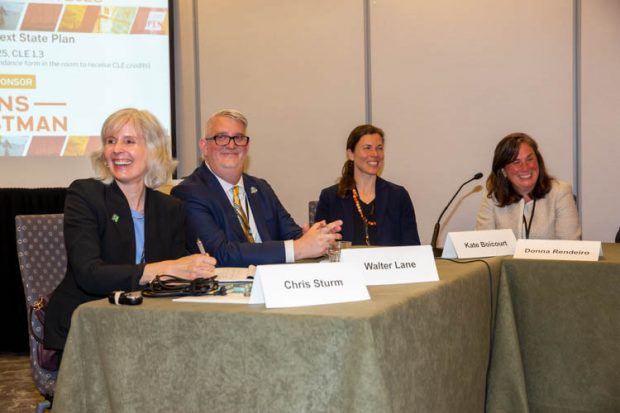
Launching the Next State Plan session at the 2023 NJ Planning and Redevelopment Conference. From left to right: Chris Sturm, Policy Director, Land Use, New Jersey Future; Walter Lane, Director, Somerset County Office of Planning Policy & Economic Development; Kate Boicourt, Director, Climate Resilient Coasts and Watersheds, New York – New Jersey, Environmental Defense Fund; Donna Rendeiro, Executive Director, New Jersey Office of Planning Advocacy. Photo by Frank H. Conlon
The State Plan “is more than a guide for land-use… it’s for public health, transportation, and much more,” stated Michael Kolber, Senior Planner for the City of Trenton, during the 2023 Planning and Redevelopment Conference as a panelist on the roundtable session Launching the Next State Plan, sponsored by New Jersey Future and the New Jersey Chapter of the American Planning Association. Despite its immense importance as a guide for the state’s future growth, New Jersey’s State Development and Redevelopment Plan has not been updated since 2001. From the demographics to geography, a lot has changed over 22 years. Launching the Next State Plan explored how to best update the State Plan to better reflect the present conditions and future outlook of New Jersey.

Launching the Next State Plan session at the 2023 NJ Planning and Redevelopment Conference. State Planning Commission members in attendance included Tom Wright, Edward McKenna, Elizabeth Terenik, Stephen Santola, Bruce Harris, and Danielle Esser. Photo by Frank H. Conlon
At this standing room only session, State Planning Commissioners and session panelists outlined the opportunities provided by the first State Plan update in two decades, and engaged in a dynamic back and forth, propelling momentum for further discussions. Donna Rendeiro, Executive Director of the New Jersey Office of Planning Advocacy, and Peter Kasabach, Executive Director of New Jersey Future, served as the session’s moderators, overseeing the convening of State Planning Commission members and interested stakeholders. The panel sought to answer the following three essential questions: First, if the State Plan update is successful, what would be different in New Jersey? Second, how should the updated Plan differ from the current one? Third, how can the Plan be implemented to ensure good land use outcomes? Tom Wright, Chair of the Commission, kicked off the session by articulating the importance of the State Plan as both a policy framework and a forum for balancing planning issues. When the State Plan was last updated in 2001, it was designed to direct growth, development, and preservation decision-making, but it had almost no consideration for climate change or equity. Emphasizing and strengthening the planning and implementation processes of the State Plan are crucial to its success.

The audience engaging in launching the next state plan at the 2023 NJ Planning & Redevelopment Conference. Photo by Frank H. Conlon
Panelists recommended specific ways to address the issue of climate change in the State Plan. Walter Lane, the Director of the Somerset County Office of Planning Policy and Economic Development, explained the need to protect communities from rising sea levels, higher precipitation rates, frequent flooding, and repeated storms by incorporating climate-resilient land-use policies, transportation systems, and economies into the State Plan. Chris Sturm, Policy Director for Land Use at New Jersey Future, explained the significance of incorporating a geographic framework for climate change adaptation planning so that communities can plan earlier rather than later. Sturm suggested that the updated State Plan could designate the coastal region as a Special Resource Area and lay the groundwork for future designation of highly-developed areas that should be fortified, areas where retreat is inevitable, and areas in-between. Including climate change related goals and metrics offers a unique opportunity to bring together and utilize up-to-date data in order to establish measurable targets, explained Kate Boicourt, the Director of Climate Resilient Coasts and Watersheds in New York and New Jersey for the Environmental Defense Fund.
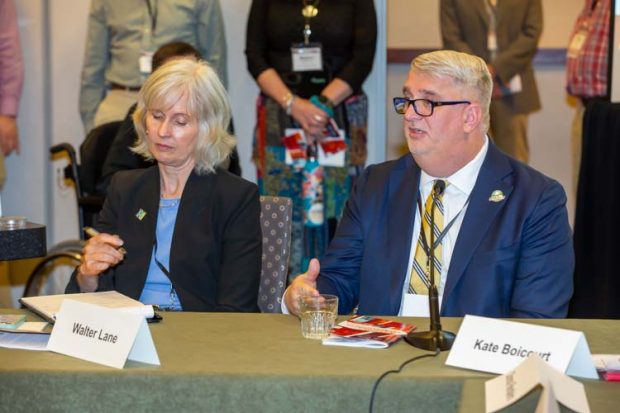
Walter Lane, the Director of the Somerset County Office of Planning Policy and Economic Development, speaking during the 2023 NJ Planning & Redevelopment Conference. Photo by Frank H. Conlon
Incorporating equity as a central tenet of the updated State Plan will ensure its ultimate effectiveness in improving the lives of all New Jerseyans.
The national emphasis on inclusivity and equity among government, corporations, and nonprofits provides New Jersey the opportunity to incorporate equity as a central tenet of the updated State Plan to ensure its ultimate effectiveness in improving the lives of all New Jerseyans. In particular, a concerted effort to include environmental justice in planning is overdue. This is especially true in NJ, given our state’s history of overlooking the interests of those who are most vulnerable. Kandyce Perry, the Director of the Office of Environmental Justice in the New Jersey Department of Environmental Protection, made it clear that New Jersey’s overburdened communities need to be explicitly protected from over concentrations of pollution and its effects. She identified the monumental importance of infusing environmental justice and equity into the updated State Plan. Because of the history and demographics of our state, Michael Kolber, the Senior Planner for the City of Trenton, explained that the best way to address environmental justice is through cross-municipality and regional planning. Along with climate vulnerability and concentrated pollution, New Jersey’s equity issues include housing affordability. George Vallone, the Founder and President of the Hoboken Brownstone Company, expressed concern about the lack of housing supply in the state, observing that statewide roughly 18,000 homes were for sale in May 2022, whereas only 13,000 homes were for sale by May 2023. Vallone urged the updated State Plan to make it easier and faster for housing to get built. Doing so will decrease housing costs and increase housing supply, thus reducing demand on limited housing supply and contributing to more affordable communities.

From left to right: George Vallone, Founder & President, Hoboken Brownstone Company; Kandyce Perry, Director of the Office of Environmental Justice in the New Jersey Department of Environmental Protection; Janice Kovach, Mayor, Town of Clinton during the 2023 NJ Planning & Redevelopment Conference. Photo by Frank H. Conlon
“Mayors need to be at the table and not on the menu.” Janice Kovach, Mayor of the Town of Clinton.
For a successful State Plan update, “mayors need to be at the table and not on the menu,” Janice Kovach, the Mayor of the Town of Clinton, cautioned. Kovach continued to highlight the importance of communication and coordination between state agencies and municipalities, so that all levels of government are on the same page. Boicourt agreed that there must be a two-way dialogue between municipalities and the state during the planning process. Lane suggested that Counties can play a more prominent role between the state and municipalities, explaining that counties should be more than negotiating entities for the State Plan since they are equipped to provide assistance to local communities and develop regional plans, like Somerset County’s Investment Framework. Panelists also stressed the importance of the implementation process. Gil Medina, the Executive Vice President of CBRE, insisted that the process starts and ends with the governor’s leadership. He explained that State Planning is not a partisan issue, thus every governor should understand its importance; the governor and their cabinet must be committed to implementing the updated State Plan in order for everyone else to follow suit, otherwise the process will fail.
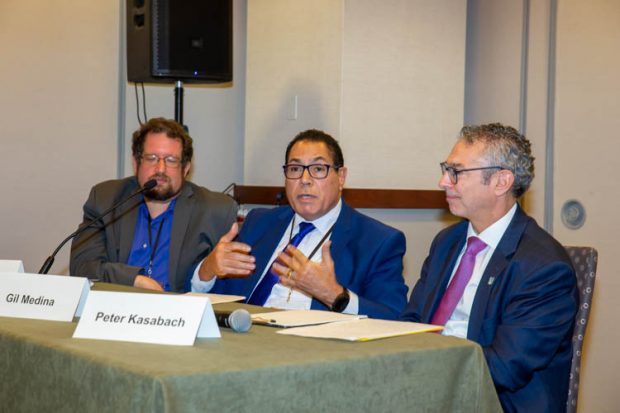
Gil Medina, Executive Vice President, CBRE, speaking during the 2023 NJ Planning & Redevelopment Conference. From left to right: Michael Kolber, Senior Planner, City of Trenton; Gil Medina, Executive Vice President, CBRE; Peter Kasabach, Executive Director, New Jersey Future. Photo by Frank H. Conlon
The 2023 Planning and Redevelopment Conference session, Launching the Next State Plan, provided a forum for how to best update the State Plan. Incorporating climate change and equity will be immensely influential to the effectiveness and relevance of the State Plan, but so is addressing key issues regarding its structure, what it can accomplish, who will participate, and how they will participate. As this crucial planning process begins it is critical for public engagement and input; therefore Donna Reindeiro of the New Jersey Office of Planning Advocacy welcomes you to submit your comments (Stateplan comments
comments sos
sos nj
nj gov) .
gov) .
Examining the Influence of 50 years of Hip Hop on Planning and Redevelopment
July 18th, 2023 by Michael Atkins
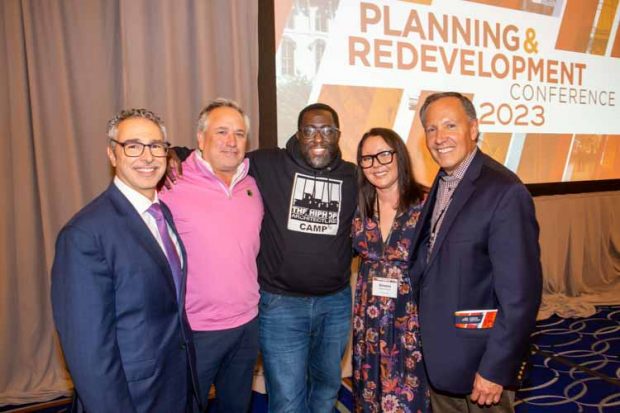
From left to right: Peter Kasabach, Executive Director, New Jersey Future; Charles Latini, President, American Planning Association – NJ Chapter; Michael Ford, Founder, BrandNu Design Studio; Sheena Collum, Executive Director, American Planning Association – NJ Chapter; Thomas Dallessio, Vice President of Policy, American Planning Association – NJ Chapter . Photo by Frank H. Conlon
On the occasion of hip hop’s 50th birthday, media companies, nonprofits, and the general public are charting the massive influence of this musical and cultural phenomenon on all aspects of modern life. This was no different at the 2023 Planning and Redevelopment Conference, co-hosted by New Jersey Future and the American Planning Association NJ Chapter, where two sessions addressed hip hop and its intersection with planning and architecture.
As the keynote speaker at the conference’s third and final day, Mike Ford captivated the audience by sharing his perspective and life experience as a hip hop architect. Ford began by reaching back a century ago to tell the story of Black influence on architecture, pointing to an infamous, albeit problematic, rendezvous between jazz great Josephine Baker and her unrequited and unscrupulous admirer, Le Courbusier. “Jazz is more advanced than architecture…if architecture were at the point reached by jazz, it would be an incredible spectacle,” Le Corbusier observed in the height of his obsession with Baker, whom he met on a cruise while the singer was a major performer in 1920s Paris. To mark this chance encounter that altered the trajectories of both music and architecture, Ford led the attendees through a sing-a-long rendition of Biz Markie’s “Just a Friend”.
Ford then launched into a pointed but popular criticism of modern planning and design, pointing to the massive attention paid in today’s society to conduct proper, inclusive outreach across racial lines, while hip hop as an art form has chronicled the history of dispossession, economic exclusion, and the built environment throughout its entire history. “As design professionals, if we can listen to the words of hip hop artists, then we can listen and see the criticisms they have been raising for 50 years and counting.”
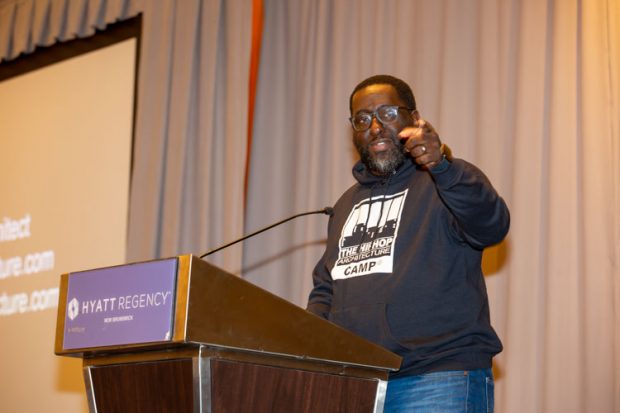
Michael Ford, Founder, BrandNu Design Studio, speaking during the 2023 NJ Planning and Redevelopment Conference. Photo by Frank H. Conlon
“Hip Hop is a reflection of the built environment.” – Mike Ford
Ford recounted his various endeavors working with youth cohorts to address the built environment. Hip Hop Architecture Camp introduces young people to architecture through a culturally relevant pedagogy. Young people deconstruct the lyrics and complexity of hip hop’s rhythm, texture and patterns, construct 3D models, often their first exposure to forming these types of models, of cities to reflect the lyrics of a given hip hop song and compare lyricists, and write their own original rhymes. Ford uses hip hop as a point of access to civic and racial history to engage, for instance, Detroit youth and the history of displacement and segregation through highway infrastructure development.
Ford has participated in a variety of projects throughout North America that have blended hip hop sensibilities into contemporary urban needs. A prominent example being the Universal Hip Hop Museum (Bronx, NY), a mixed use building with the bottom two floors providing space for the museum and a housing complex boasting 526 affordable units above. Ford is also involved in the highly anticipated Black Inventors Hall of Fame, coming to Newark, NJ, to honor the history of their contributions to American history. According to the project’s website, “The museum is envisioned to be a 31,000 sq ft. facility with state of the art, tuition free STEAM classrooms, theater, Metaverse library, startup incubator, and a Legends Hall featuring the top Black inventors of the Golden Era in this country.” As to why these stories must be told through a museum, “Because when you build public spaces, it matters.”
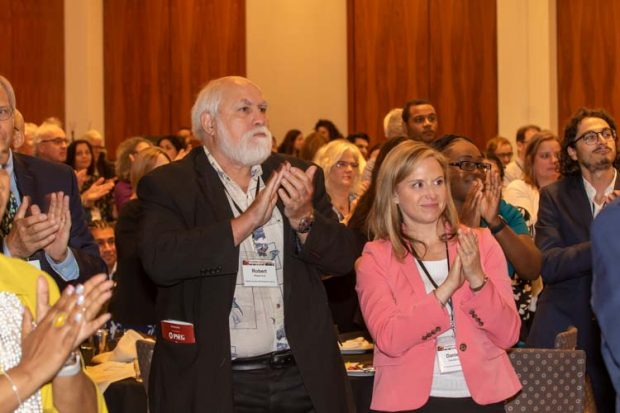
Standing ovation after Michael Ford’s keynote, Hip Hop Beyond Beats and Rhymes, Architecture Beyond Bricks and Mortar, at the 2023 NJ Planning and Redevelopment Conference. Photo by Frank H. Conlon
In conclusion, Mike Ford provided the following closing remarks to a standing ovation: “Hip Hop architecture is not just an idea or academic pursuit. It’s not just whimsical and fun and making curvy [stuff] because it has to be tied to hip hop. To me hip hop sustains life. When you can combine hip hop, architects, and designers, we can do some amazing things. Teaming hip hop artists with humanitarian projects can accomplish great things.”
A second session at the Planning and Redevelopment Conference dedicated to exploring the influence of hip hop was titled, “Hip Hop Will Save Your Life”, featuring speakers LaTricea Adams, Founder CEO & President, Black Millennials 4 Flint; Russell Armstrong, Climate and Environment Policy Director, Hip Hop Caucus; Darren Harris, Founder and CEO, PANN TV; and moderated by Tomas Varela, Executive Director, New Jersey Black Empowerment Coalition.

How Hip Hop Will Save Our Life virtual session at the 2023 NJ Planning and Redevelopment Conference. Top row from left to right: Tomas Varela, Executive Director, New Jersey Black Empowerment Coalition; LaTricea Adams, Founder CEO & President, Black Millennials 4 Flint. Bottom row from left to right: Russell Armstrong, Climate and Environment Policy Director, Hip Hop Caucus; Darren Harris, Founder and CEO, PANN TV.
Adams explained why the Flint Water Crisis resonated so deeply and broadly with Black culture and the hip hop community, stating, “While the issue began in 2014, it wasn’t until a year later that most of American became aware of the crisis.” Suspicions among local community members that their majority Black city wasn’t being told the truth about their water supply raised long-standing concerns that challenged the perceived social progress in America, begging the question: Why are we still fighting for the most basic of civil rights?
The Hip Hop Caucus was formed a full decade before the Flint Water Crisis, at that time primarily addressing voting rights before quickly expanding into intersectional issues around environmental and economic justice in the wake of Hurricane Katrina’s devastation, which disproportionately impacted Black communities in the South. On the subject of integrating artists into public campaigns, Armstong noted that artists have to live off of their own fame, but want to speak on issues they care about, whether it be a local water issue or fundraising for relief in the aftermath of a hurricane. Armstrong stated, “Outside of Jackson and Flint, we had a water crisis in NJ. These are issues that the Black community has known about for a long time before the mainstream media picks up on these issues. The same issues we are talking about are the same ones that hip hop artists are passionate about. As the Hip Hop Caucus, we respect that.”
“Nothing wrong bringing the culture into advocacy. Everyone can be involved.” –Russell Armstrong, Hip Hop Caucus
Harris, for his part, has founded and operates a media platform with exactly that capacity. Harris recounted the growth of his online media platform, PANN TV, and their approach of crowdsourcing material pertinent to their audience. He pointed to two prominent examples of the influence of hip hop, both near and far. “At this point hip hop is not just the music, it’s how we look, how we speak, the way we look when we walk into a room. The Mayor of Newark, Ras Baraka, is a representative of the hip hop community…and diaspora.” Harris continued by pointing to the life and legacy of Nipsey Hussel, who, before his murder, was an influential figure in both the musical and his local communities. Hussel was a local icon in South Los Angeles, where he bought real estate, opened businesses and resource centers for youth. Before his death, he took an active role in planning and advising “Destination Crenshaw”, a public private partnership between the city, county metro, and private business to open a mile long open-air celebration of Black Culture in LA along Crenshaw Boulevard, LA’s historic Black commerce district, in conjunction with the expansion of metro service to the airport and newly constructed professional football stadium.
In their concluding remarks, Adams and Harris both encouraged attendees to value artists and Black media in shaping public goods, services, and spaces. Armstrong concurred, advising, “Nothing wrong bringing the culture into advocacy. Everyone can be involved. Every different generation can engage in this work. Folks want to bring their full selves into the work they are doing on a day to day basis.”
Common Ground Emerges on Affordable Housing Solutions
July 17th, 2023 by Chris Sturm
“New Jersey has a storied history of working to address affordable housing. For over five decades, municipalities and developers have collaborated and/or clashed in state agencies and in the courts,“ noted Tom D’Allessio, Vice President of Policy, American Planning Association, NJ Chapter, as he opened one of the two lively, productive sessions on affordable housing at the 2023 Planning and Redevelopment Conference. The panelists on these sessions, representing municipal and state officials, housing advocates, planners, and developers at times clashed. Their disagreements, always respectful, included opposing views on the state mandate to build affordable housing in affluent communities, the value of a court-supervised process, the ability of regional planning to facilitate development, and the root causes of local opposition.
Despite diverging perspectives, the speakers found broad consensus on key aspects of affordable housing, including the growing need, remarkable progress, unproductive litigiousness, and the importance of addressing long-standing impediments. A panel titled, Fourth Round Obligations: For Whom? By Whom?, addressed the process by which affordable housing is planned and built pursuant to legal requirements under the Mt. Laurel doctrine. A second panel, Confronting New Jersey’s Housing Affordability Crisis, focused on removing obstacles to developing housing that is affordable to both low- and moderate-income families and also the “missing middle”. New Jersey Future and the New Jersey Chapter of the American Planning Association sponsored the conference.
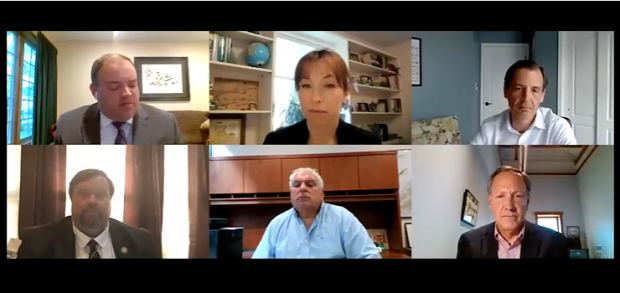
The panel during the 2023 NJ Planning and Redevelopment Conference virtual session Fourth Round Obligations: For Whom? By Whom? Top row from left to right: Josh Bauers, Senior Staff Attorney, Fair Share Housing Center; Elizabeth McManus, Co-founder, Kyle + McManus Associates, LLC; Jeff Kolakowski, Chief Executive Officer, New Jersey Builders Association. Bottom row from left to right: Paul Muir, Mayor, Bethlehem Township; Ben Spinelli, Executive Director, New Jersey Highlands Council; Thomas Dallessio, Vice President of Policy, American Planning Association – NJ Chapter.
Opportunities for moving forward in the Mt. Laurel Fourth Round. Panelists in the session, Fourth Round Obligations: For Whom? By Whom?, focused on the phase beginning July 1, 2025. Josh Bauers, Senior Staff Attorney, Fair Share Housing Center, listed successes achieved during the past eight years of the Mount Laurel process: more towns (345) have court settlements in place, and 22,000 units of housing affordable to low- and moderate-income households have been built. Paul Muir, mayor of Bethlehem Township and president of the NJ Conference of Mayors, shared his hope for a regional planning approach overseen by a state agency that limits housing obligations based on available support services. Ben Spinelli, executive director of the New Jersey Highlands Council, also argued for a regional approach consistent with the Highlands Regional Master Plan to ensure protection of the drinking water supply. “But where will we grow as a state?” asked Jeff Kokakowski, chief executive officer, New Jersey Builders Association, in the face of limited vacant land and many regulatory requirements. Beth McManus, co-founder, Kyle + McManus Associates, LLC, cautioned that regional planning works well for preservation but makes it “harder to get to growth.”
The speakers found common ground on the need to make the planning and development process more efficient in the Fourth Round. Speakers urged communities to start planning now and quickly reach agreement on housing requirements so, as Ben Spinelli said, “we can spend the time building.”
Panelists recommended that state agencies:
- Coordinate permitting issues across agencies and ensure that road, sewer, water, and transit capacity are available to make development in good locations as easy as possible. (Spinelli and McManus)
- Provide clear direction on where compact development can occur, given multiple, sometimes inconsistent, state regulations. (Kolakowski)
- Determine municipal obligations well in advance of the July 2025 deadline to make it easier and cheaper to get through the settlement process. (McManus)
- Revise regulations to ensure that affordable units are properly integrated into inclusionary projects and are built to similar sizes and standards as market rate units. (McManus)
Panelists recommended that municipal officials:
- Identify areas appropriate for higher density development, which are supported by services, schools, and public facilities. (McManus)
- Lay the groundwork for growth by explaining how it can be positive for the community. (McManus)
- Cooperate with, rather than litigate, the process, and build on experience from the third round. (Bauer)
- Learn how to use the redevelopment statutes and accompanying tools. (Bauer)
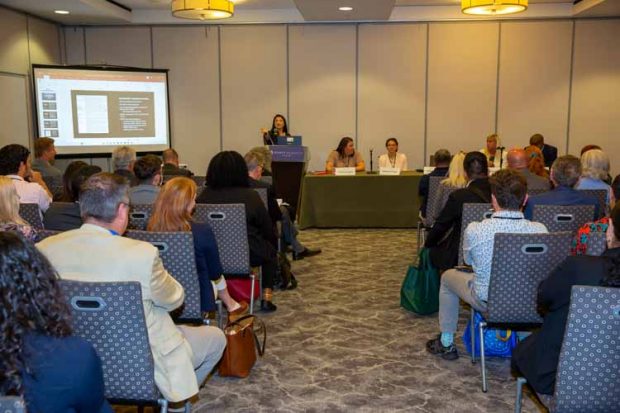
The Confronting New Jersey’s Housing Affordability Crisis session at the 2023 NJ Planning and Redevelopment Conference. Photo by Frank H. Conlon
The framework for providing low, moderate and middle-income housing. Jong Sook Nee, member, Convergent Law, kicked off Confronting New Jersey’s Housing Affordability Crisis with statistics illustrating the extent of the problem. For example, she noted that only 21% of for-sale homes are considered “affordable,” and Northern New Jersey ranks as the nation’s most competitive rental market. Jong outlined many approaches for providing affordable housing including municipal housing authorities, privately owned and operated housing, and the Mount Laurel process, as well as the use of subsidy tools including Low Income Housing Tax Credits, municipal Payments in Lieu of Taxes, and state incentive programs.
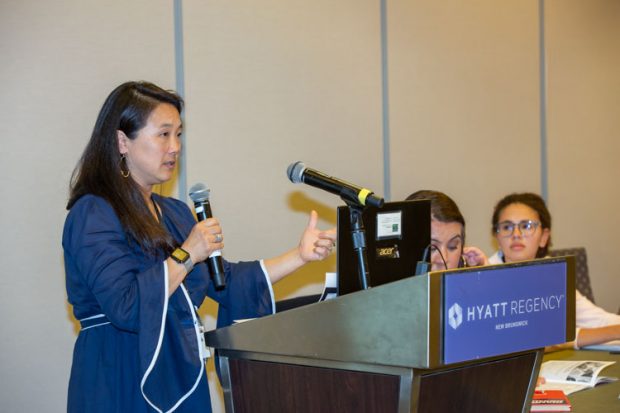
Jong Sook Nee, Member, Convergent Law, speaking during the 2023 NJ Planning and Redevelopment Conference. Photo by Frank H. Conlon
Key challenges: zoning and development process. The four panelists in this session fell into two groups when asked to identify the greatest challenges facing housing affordability. Lorissa Luciani, administrator of affordable housing at the NJ Department of Community Affairs, and Katherine Payne, director of land use, Fair Share Housing Center, cited zoning constraints, including the need for more multi-family zoning and opportunities for dense redevelopment. The panel’s two developers highlighted the importance of the development process. “Process is the hurdle to supply,” noted Deb Tantleff, founding principal of Tantum Real Estate. Patrick Teborg, founder, TD+ Partners, described the benefits of working with “a process-driven municipality” like Plainfield where win-win solutions can be found relatively quickly when the city and the developer employ a “problem-solving” approach. Teborg noted the difficulty of working in affluent municipalities that seek to obstruct affordable housing.
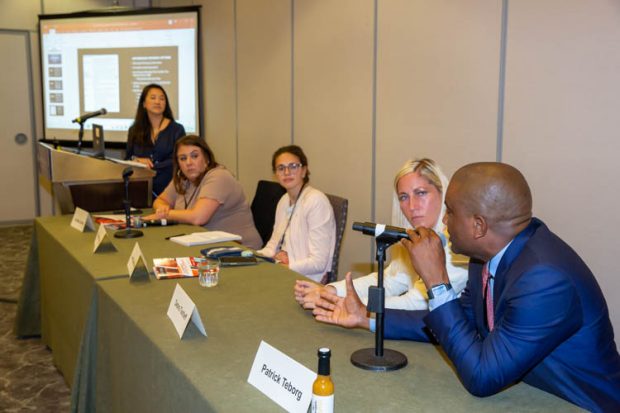
Patrick Terborg, Founder, TD+ Partners, speaking during the 2023 NJ Planning and Redevelopment Conference. Photo by Frank H. Conlon
Actionable recommendations. As with the other housing session, panelists offered actionable recommendations for increasing the supply of housing that is affordable.
Panelists recommended that state agencies:
- Provide a standardized checklist for site plan submission and clarity on buildable locations especially near flood zones. (Deb Tantleff)
- The NJ Housing Mortgage Finance Agency should reform its Low Income Housing Tax Credit program to allow broader participation, including by market-rate developers. (Teborg)
- The Department of Community Affairs (DCA) should dramatically revamp parking requirements in the Residential Site Improvement Standards (Tantleff).
- Ensure, through the Mount Laurel process, that all communities are accessible to people with lower incomes, including those with good schools and other amenities. (Payne)
Panelists recommended that municipal officials:
- Explore newly-funded DCA subsidy programs, which may grant waivers to address record-high per unit construction costs. (Luciani)
- Work with Mount Laurel Fourth Round process, in recognition of the Third Round’s “incredible productivity” at producing multi-family and affordable housing units. (Payne)
- Streamline the process to reduce the time to construction, learn about real estate finance, and loosen zoning restrictions that prevent the kinds of units that consumers want. (Tantleff)
- Provide a transparent, respectful process for developers. (Teborg)
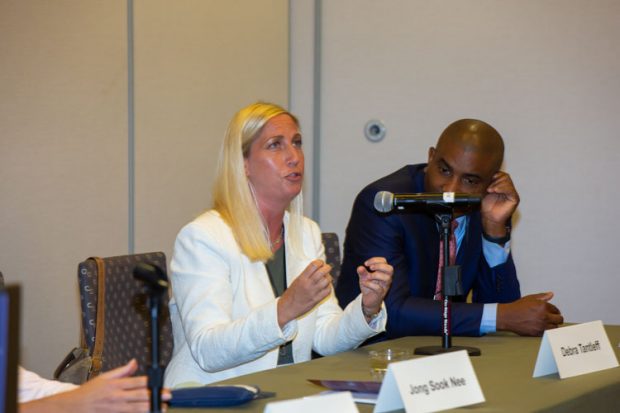
Debra Tantleff, Founding Principal, Tantum Real Estate, speaking during the 2023 NJ Planning and Redevelopment Conference. Photo by Frank H. Conlon
Multi-family housing— the market, the opposition, the constraints. An animated discussion period offered opportunities for panelists and attendees alike to explore the root causes of local opposition to multi-family and affordable housing: racism, fear of density, and “change,” including more traffic and loss of green space. Deb Tantliff recommended local officials focus the conversation on people—in addition to the well-documented demand for compact housing by the under 35 crowd, current residents may want to stay in town and live in more compact units, especially in-town aging baby boomers and recently-divorced parents. The developers noted that “missing middle” or “workforce” housing is hard to build given high fixed costs, especially in affluent communities, and that deed-restricted units for households earning between 80% and 120% of the median may be unable to get financing.
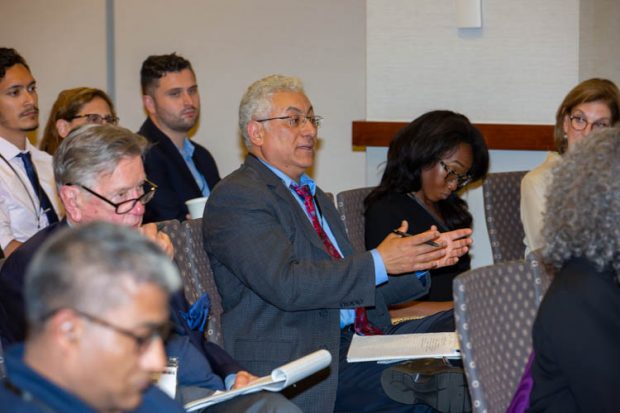
Discussion with the audience during the Confronting New Jersey’s Housing Affordability Crisis session at the 2023 NJ Planning and Redevelopment Conference. Photo by Frank H. Conlon
Housing affordability lies at the heart of New Jersey Future’s commitment to creating strong, healthy, resilient communities for everyone. The Planning and Redevelopment Conference provided an important opportunity for tackling the issue, including two additional sessions on the topic that are not covered here: Resilient and Affordable: Planning for Your Affordable Housing Obligation in the Era of Climate Change and The Changing Faces of New Jersey Developers. Both conference sponsors, New Jersey Future and the New Jersey Chapter of the American Planning Association, plan to hold additional forums to identify ways to ensure well-planned housing that is affordable to people of all means.
Ch-Ch-Ch-Changes! How Water Utilities and Communities are Addressing Changing Climate, Changing Regulations and Changing Lead Pipes!
July 17th, 2023 by Cassie Bolinger
“Water is the only utility you ingest,” noted Mark McDonough, President of New Jersey American Water, as he reflected on the serious responsibility that water utilities have to protect the health of the communities they serve. To deliver on this responsibility, water utilities must address ever-changing environmental challenges.
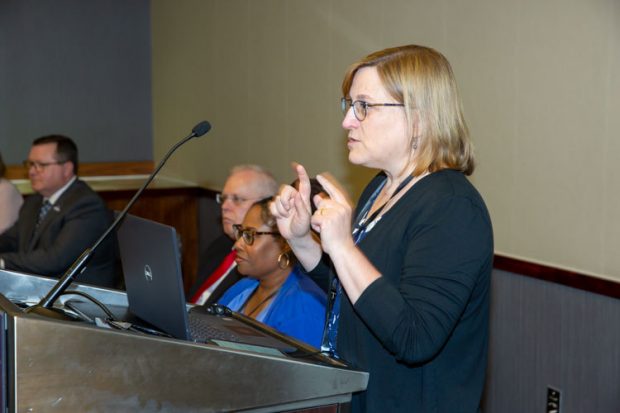
Diane Schrauth, Policy Director for Water at New Jersey Future, moderating the session Ch-Ch-Ch-Changes! How Water Utilities and Communities are Addressing Changing Climate, Changing Regulations and Changing Lead Pipes! during the 2023 NJ Planning and Redevelopment Conference. Photo by Frank H. Conlon
These challenges, and how water utilities are keeping up, were discussed during the session titled ”Ch-Ch-Ch-Changes! How Water Utilities and Communities are Addressing Changing Climate, Changing Regulations and Changing Lead Pipes!” during the 2023 NJ Planning and Redevelopment Conference, co-hosted by New Jersey Future and the New Jersey Chapter of the American Planning Association. Moderated by Diane Schrauth, Policy Director for Water at New Jersey Future, McDonough joined fellow leaders in the water sector, Nicole E Brown, Client Development Manager, Suburban Consulting Engineers; Judy Karp, Assistant Director and Legal and Compliance Officer, New Jersey Infrastructure Bank; and Mark Tompeck, Sr. Vice President and Practice Leader, Water, Mott MacDonald on the panel.
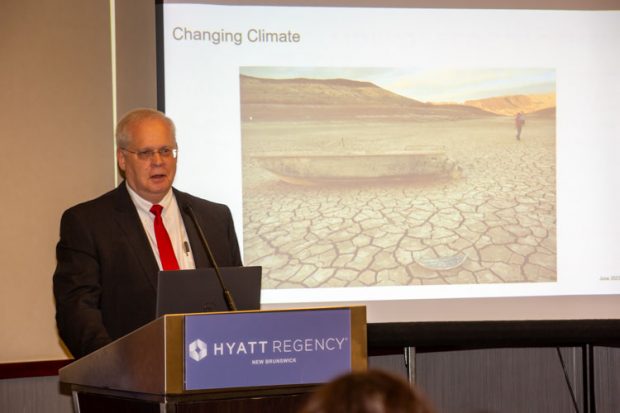
Mark Tompeck, Sr. Vice President and Practice Leader, Water, Mott MacDonald, speaking during the 2023 NJ Planning and Redevelopment Conference. Photo by Frank H. Conlon
Mark Tompeck of Mott MacDonald, a global engineering, management, and development firm, opened the panel by providing an overview of the major environmental challenges necessitating changes in the water sector. As extreme weather events increase in frequency and intensity due to climate change, Tompack explained, the water sector must employ collaboration and long-term planning to ensure system resiliency and prepare for the impact on water quality and quantity. Tompeck pointed out that proposed drinking water standards that would limit two chemicals associated with an increased cancer risk from long-term exposure, per- and polyfluoroalkyl substances (PFAS) and 1,4-dioxane, will require updates to utility equipment and operations. Additionally, Tompeck noted that New Jersey legislation requiring the removal of lead service lines by 2031 is a massive undertaking for utilities as they identify where lead service lines exist, plan for replacement, finance replacement, and communicate with residents.
“Water is the only utility you ingest.”
How are leaders in the water sector navigating these challenges? Mark McDonough (New Jersey American Water) highlighted the importance of consistent investment in water infrastructure, stating “the fact of the matter is…if we didn’t recapitalize our systems on a regular basis…they can’t take the stress and pressure of operating under those conditions.” To communicate these changes with the public, he advised utilities to “go out into the communities, have a conversation,” and “don’t be afraid that people may challenge you.”
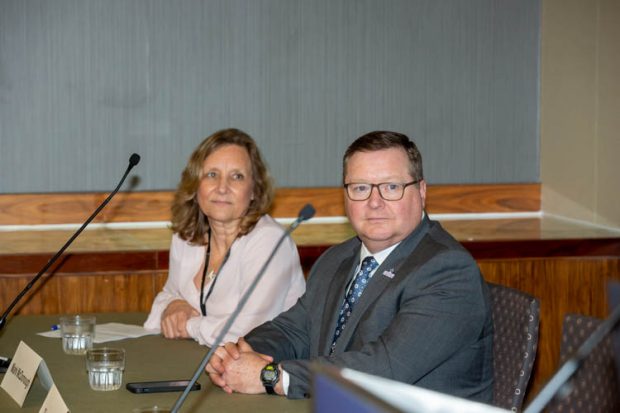
Mark McDonough, President, New Jersey American Water, and Judy Karp, Assistant Director and Legal and Compliance Officer, New Jersey Infrastructure Bank, on the panel for the session Ch-Ch-Ch-Changes! How Water Utilities and Communities are Addressing Changing Climate, Changing Regulations and Changing Lead Pipes! during the 2023 NJ Planning and Redevelopment Conference. Photo by Frank H. Conlon
Nicole E. Brown (Suburban Consulting Engineers) expressed the need for greater access to funding for water systems and spoke to the importance of detailed planning for stakeholder engagement when reaching out to community members. “Who are your stakeholders?” she probed, “What does your school nurse think of it? What does a parent think of it? What does a kid think of it?” Brown also emphasized the value of diversifying the majority white, male water workforce to foster innovative solutions, commenting, “that level of appreciation of the voices in the room that lead to the innovation is what we as an industry have to do.”
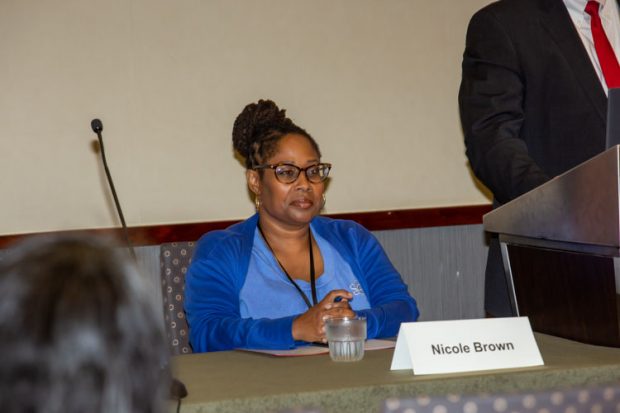
Nicole E Brown, Client Development Manager, Suburban Consulting Engineers, on the panel for the session Ch-Ch-Ch-Changes! How Water Utilities and Communities are Addressing Changing Climate, Changing Regulations and Changing Lead Pipes! during the 2023 NJ Planning and Redevelopment Conference. Photo by Frank H. Conlon
How can water systems meet the funding demands of these necessary infrastructure changes? Judy Karp (New Jersey Infrastructure Bank) encouraged water utilities to apply for financing through the New Jersey Infrastructure Bank (I-Bank), highlighting their technical assistance programs and principal loan forgiveness for projects that address lead and PFAS. “There is a lot of money coming through our programs right now through BIL [Bipartisan Infrastructure Law] and ARPA [American Rescue Plan Act],” she explained. Karp also announced that I-Bank has applied for funds from the Federal Emergency Management Agency (FEMA) to issue bonds for the financing of hazard mitigation and resilience projects.
Managing water and wastewater systems is a complex task and important to consider as localities plan for their future. In this panel, water leaders described how they address the simultaneous impacts of climate change, emerging chemical contaminants, and lead service line replacements through long-term planning, capital investments, new technology, collaboration, building public trust, and diversifying the workforce. Tompeck commented during the session, issues such as micro-plastic contamination and lead in household plumbing fixtures are not currently regulated, but pose concerns for public health and the water sector. As we look toward the future of water infrastructure in New Jersey, these methods will remain necessary as new challenges arise.
Planning for Climate Resilient Stormwater Infrastructure
July 17th, 2023 by Patricia Dunkak
“Watersheds are not political and do not follow political delineations,” said Mayor Andrew Nowick from the City of Lambertville at the 2023 NJ Planning and Redevelopment Conference (NJPRC). As flooding increases due to increased intense rain events and aging stormwater infrastructure, it is more important than ever to plan ahead to protect all New Jerseyans in the face of climate change. A recent NJ Department of Environmental Protection (NJDEP) and Northeast Regional Climate Center study found that the 100-year storms are projected to increase as much as 50%, placing areas not previously in flood zones at risk of severe flooding. Additionally, many waterways in NJ are impaired, which is due in part to non-point source pollution generated by stormwater runoff that is worsened by large quantities of impervious cover. Stormwater rules and permits are being updated in New Jersey to manage both current and future storms, and are encouraging holistic watershed planning and regional solutions, since stormwater, as noted above, does not follow municipal boundaries.
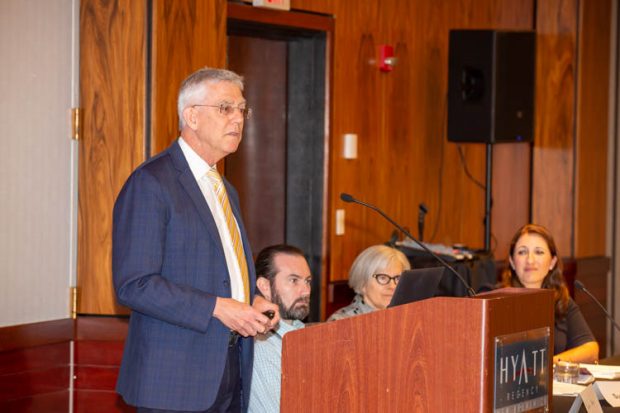
Clinton Andrews speaking during the Upstream/Downstream: Redevelopment or Retreat? Flood Protection Rules, Planning, and Mitigation session at the 2023 NJ Planning Redevelopment Conference. Photo by Frank H. Conlon
Two expert panels explored state stormwater permits and regulations, watershed planning, financial impacts, case studies, and solutions at the 2023 NJPRC sponsored by New Jersey Future and the New Jersey chapter of the American Planning Association. The session Upstream/Downstream: Redevelopment or Retreat? Flood Protection Rules, Planning, and Mitigation featured Clinton Andrews, Associate Dean for Research at Edward J. Bloustein School of Planning & Public Policy, Rutgers University, Gabriel Mahon, Bureau Chief of NJPDES Stormwater Permitting and Water Quality Management, NJDEP, Jennifer Phillips Smith, Director & Co-Chair of Real Estate Group, Gibbons P.C., and Susan Bristol, the Municipal Policy Specialist at The Watershed Institute. The session A Watershed Moment: Planning and Funding Stormwater Improvement Projects featured Mayor Nowick from the City of Lambertville, Bill Cesanek, Vice President of CDM Smith, Gabriel Mahon, Bureau Chief of NJPDES Stormwater Permitting and Water Quality Management, NJDEP, James Thompson, Campaigns Director, NJ League of Conservation Voters, and Lindsey Sigmund, Program Manager at New Jersey Future.
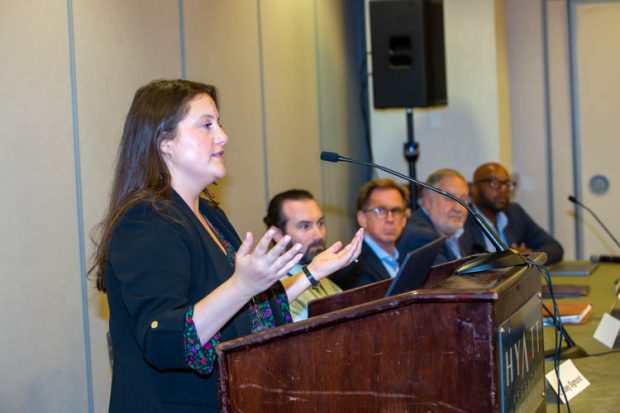
Lindsey Sigmund speaking during the A Watershed Moment: Planning and Funding Stormwater Improvement Projects session at the 2023 NJ Planning Redevelopment Conference. Photo by Frank H. Conlon
NJDEP’s Gabe Mahon provided attendees with an overview of how the state is planning to enhance climate resilient stormwater infrastructure. NJDEP issued the updated Tier A Municipal Separate Storm Sewer System (MS4) Permit, effective on January 1, 2023, which represents a major change from previous MS4 permits with the addition of a Watershed Improvement Plan requirement aimed at improving water quality and reducing flooding. This three-phased requirement includes the mapping of all stormwater infrastructure, including green infrastructure; outlining water quality improvement projects; and a final report that summarizes proposed projects, implementation schedules, and expected costs.
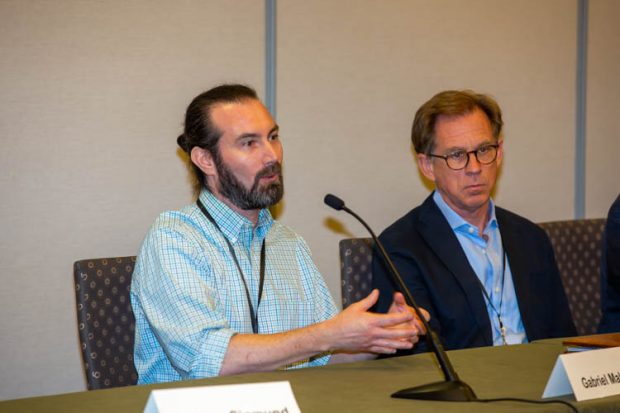
Gabriel Mahon, Bureau Chief of NJPDES Stormwater Permitting and Water Quality Management, NJDEP, speaking during the 2023 NJ Planning Redevelopment Conference. Photo by Frank H. Conlon
Another large rule change at the state is New Jersey Protection Against Climate Threats (NJ PACT), which directed NJDEP to incorporate climate change data into its regulatory and permitting programs. Phase 1 of the rule, the Inland Flood Protection Rules proposed in December 2022 and will be effective in July 2023, requires the use of updated precipitation data to analyze flood potential and design stormwater infrastructure, including green infrastructure. This rule will amend the Stormwater Management Rules, N.J.A.C. 7.8 and the Flood Hazard Area Control Act Rules, N.J.A.C. 7:13. The updated stormwater rules will require systems to be designed to manage both current and future storms. The updated permit and major rule changes will impact how and where development and redevelopment occur, which will lead to more climate resilient stormwater infrastructure.
The resiliency of our infrastructure impacts its ability to mitigate and adapt to climate change. Bloutstien’s Associate Dean Andrews emphasized that flooding not only impacts the environment, but also has municipal fiscal and economic implications. Three climate change adaptation strategies included in his presentation are: resist, accommodate, or retreat. Retreat is often a politically unfavorable strategy, but there are successful examples of retreat demonstrated by NJDEP’s Blue Acres program in the Borough of Manville Borough, Township of Wayne, and Township of Old Bridge. Blue Acres protects community members and the environment by relocating NJ families whose homes experience repeat flooding and acquire their property to be used as open space and flood storage. These municipal decisions play out in a regional watershed context.
Susan Bristol, from the Watershed Institute, emphasized the importance of changing the way we develop, which is very important in a highly developed state like NJ with large areas of impervious cover. Human development has changed the natural water cycle and has increased stormwater runoff that contributes to impaired water quality. “Unbuilding” impervious cover and redevelopment can improve stormwater management, meet requirements of the Stormwater Management Rules, and restore watersheds. While large buyouts and redevelopment occur, Jennifer Phillips Smith reminds us that these projects must be economically feasible for the water quality and restoration benefits to occur when these projects are implemented.
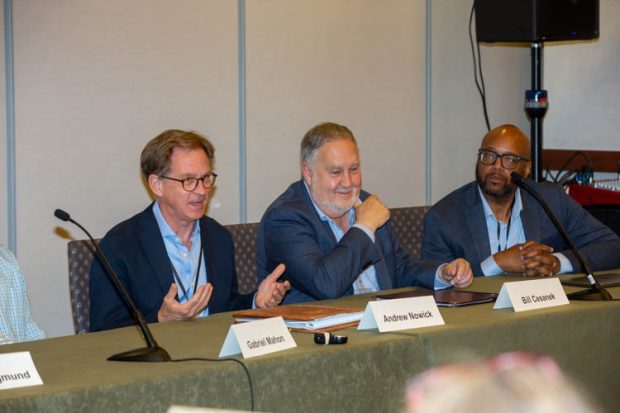
Mayor Nowick from the City of Lambertville speaking during the 2023 NJ Planning Redevelopment Conference. Photo by Frank H. Conlon
Mayor Nowick emphasized that areas not previously in a recorded flood zone are experiencing severe flooding, as seen in the City of Lambertville during Hurricane Ida. Unfortunately, flooding events like these are projected to increase due to aging water infrastructure and large areas of impervious surface. The city is using software supplied by NJDEP to map all of their stormwater infrastructure, but they still face limitations, such as staff capacity, resources, and funding. Stormwater and flooding do not follow municipal boundaries, so regional and watershed level planning are important approaches to improving water quality and reducing flooding.
Bill Cesanek underscored the importance of a holistic, integrative, and long-term watershed based planning process that is cost effective to municipalities and improves environmental health. “Watershed Improvement Planning is a key element of integrated water resource and water quality management.” A paradigm shift is required to incorporate watershed improvement planning into sustainable Master Plans. Planners, engineers, community advocates and members are all needed to work together to assist municipalities to manage stormwater, define the Level of Service needed, and meet state level requirements. It is important that watershed improvement planning is equitable, inclusive, and fairly distributes the environmental, social, and economic benefits.
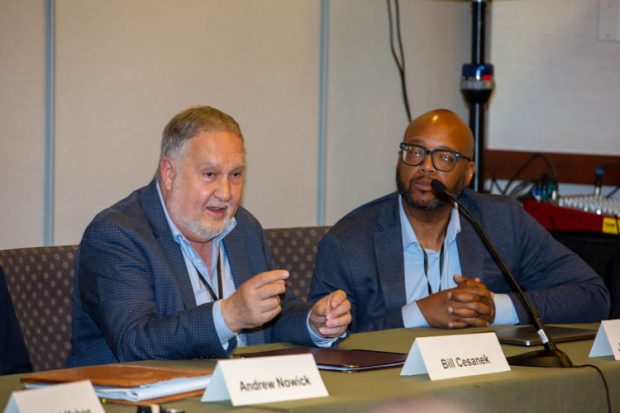
Bill Cesanek, Vice President of CDM Smith, speaking during the 2023 NJ Planning Redevelopment Conference. Photo by Frank H. Conlon
Stormwater infrastructure improvements will be expensive, but there are funding mechanisms and technical assistance available to help municipalities. NJDEP announced the availability of $19 million in stormwater assistance grants to help municipalities comply with new Tier A MS4 permit requirements, such as the mapping of all stormwater infrastructure, as Lambertville is currently undertaking. Additional funding will be necessary, and one viable option for local entities is to establish a stormwater utility. A stormwater utility is a dedicated and equitable funding mechanism to pay for a community’s stormwater management program. As James Thompson explained, there are over 2000 stormwater utilities formed in the United States, but none in NJ so far. In 2019, NJ enacted the Clean Stormwater & Flood Reduction Law that allows municipalities, counties, groups of municipalities, and sewerage and improvement authority to establish a stormwater utility. Last year, NJDEP announced the availability of Technical Assistance for Stormwater Utility Feasibility Studies, which will assist municipalities in completing a stormwater utility feasibility study.
Impaired waterways, large areas of impervious cover and development, and extreme rain events that cause severe flooding demand NJ to holistically approach watershed planning. Expert panelists at the Planning and Redevelopment Conference highlighted state level permits and rules aimed at improving water quality, climate change adaptation strategies, watershed and regional improvement planning, and funding opportunities to upgrade outdated stormwater infrastructure. New state regulations will change where and how we develop, and the solutions described will create more climate resilient infrastructure. The case studies explored and lessons learned are one step toward improving NJ’s water quality, reducing flooding, and improving quality of life in NJ.
Five Community Planning Initiatives To Solve Problems and Save Money
June 6th, 2023 by Chris Sturm
Local officials face a rapidly changing world due to forces beyond their control. Impacts from the pandemic, climate change, and the racial reckoning cannot be ignored, nor can new state government requirements, ranging from housing to flood resilience. But by investing in community planning initiatives, municipal and county leaders can solve problems, save money, and strengthen their communities. Five especially pressing community issues in 2023 are: fulfilling Mount Laurel requirements for affordable housing, growing communities without displacement, navigating real estate market shifts, adapting to climate change, and decreasing pedestrian fatalities.
Mount Laurel Requirements for affordable housing. New Jersey municipalities are experiencing accelerated construction of deed-restricted affordable housing and associated market-rate housing, as described in a new report, Dismantling Exclusionary Zoning: New Jersey’s Blueprint for Overcoming Segregation, Between 2015 and 2022 New Jersey’s Mount Laurel housing requirement resulted in the construction of nearly 22,000 new deed-restricted affordable housing units and an additional 50,000 multi-family housing units in “Mt. Laurel associated projects”. The pace of affordable housing production will increase as additional approved units are built. Meanwhile, these new housing units are creating much-needed homes for people and families across the state.
The next phase of affordable housing requirements, called “the Fourth Round,” will commence on July 1, 2025. The 350 or so affected municipalities can begin planning now for Fourth Round requirements so they can increase supply, variety, and affordability of housing stock and remain an attractive place for households of all types and incomes. Proactive municipalities are identifying the most advantageous sites and getting them ready. Win-win-win sites are well-located near jobs, schools and shopping; redevelop vacant or underutilized properties rather than natural lands; are served by water infrastructure, and are resilient to flooding. Sites in downtown locations can also boost economic development. But some of the best sites have obstacles to housing production that take time to resolve. Municipalities that begin now will find themselves better able to steer future housing construction than those that wait until deadlines loom. Adopting an inclusionary zoning ordinance that requires a share of new housing units be affordable gives municipalities another head start.

Inclusive Communities. Affordable housing in affluent areas represents just one side of the coin when it comes to reducing the high racial and economic segregation of New Jersey’s communities. It can be complemented by attracting market-rate development to poorer communities—but only if those developments benefit, rather than harm, existing residents and businesses. For example, new market-rate development can spark a wave of investment that escalates rents and property taxes, which in turn displaces residents and small businesses. Redevelopment planned without community input can undermine neighborhood cohesion and quality of life.
Proactive cities are finding ways to ensure residents benefit from new investment. Jersey City, Newark, and others have adopted inclusionary zoning ordinances that require creation of affordable housing units as a part of new development projects. This ensures some units remain affordable to those with lower incomes even as real estate values rise. If well structured, Community Benefit Agreements can ensure that developers provide tangible benefits tailored to local needs. For example, they can guarantee jobs for local residents, deliver investments in desired neighborhood amenities, and ensure local input into project designs. Community Benefits Agreements (CBAs) are now required for certain projects funded through two of the New Jersey Economic Development Authority’s tax incentive programs. Cities can employ many additional strategies, including giving existing residents a strong voice in decision-making.
Real Estate Market Shifts. The coronavirus pandemic accelerated market forces that are reshaping communities. The shift to remote work and hybrid schedules have cut office occupancy rates, affecting the vitality of downtowns, office parks and corporate campuses, and undermining restaurants and other businesses that cater to workers. The surge in e-commerce has also hurt the already shrinking storefront retail sector. Some of these trends may revert to pre-pandemic levels as the pandemic recedes, but others are likely to stick, and local governments need to adapt.
Cities and towns are beginning to seek ways to convert vacant office and retail spaces for new uses, such as housing, which is in short supply in New Jersey. Suburban office parks and malls offer opportunities for creating new mixed-use centers where none existed before, by repurposing existing buildings and by adding new buildings and uses on surface parking lots.
E-commerce has also fueled a spike in demand for warehousing, superimposed on top of trends in international trade that are increasing the volume of goods arriving at the state’s major ports in North Jersey. The rising demand for logistics facilities of all sizes has caught many communities by surprise. Affected municipalities can employ the tools provided in the Warehouse Siting Guidance from the Office of Planning Advocacy in order to proactively plan for and locate warehouse development in a manner that avoids negative impacts.
At the same time, New Jersey’s population is aging, and many municipalities are working to design their communities in ways that support older adults. Changes that help us remain in our communities as we age also benefit people of all ages. These include having a greater range of housing options, providing equitable access to open spaces and other facilities, supporting downtown economies, and improving transportation and walkability.
Flooding and other Climate Change Impacts. Due to sea level rise in coastal areas, and more intense precipitation events statewide, many developed areas face more frequent and more intense flooding. In response, the NJ Department of Environmental Protection has updated projections for precipitation and sea level rise and municipal permits addressing water quality, particularly due to stormwater runoff. The Department is also considering multiple regulations that will impact municipal stormwater management, development in flood prone areas, and re/development standards.
Prudent municipalities are investing resources to assess their vulnerabilities to climate change and understand new regulatory and planning requirements. A climate change-related hazard vulnerability assessment, now required in the land use element of municipal master plans, is a foundational first step in local climate adaptation; stay tuned for detailed guidance from New Jersey Future later this year. Strategies to limit flood damage to property and people include better stormwater management, more resilient design standards, and in some places, transitioning away from high hazard areas through zoning changes and NJDEP Blue Acres buyouts. In order to fund infrastructure improvements that address flooding, many towns are exploring creation of a stormwater utility.
 Pedestrian Safety. In a 2022 report, New Jersey ranked as the 19th most dangerous state for pedestrians, with 870 pedestrian deaths in the five-year period between 2016 and 2020. The most dangerous roads in New Jersey for pedestrians are usually four- or six-lane highways in developed areas with a large amount of commercial businesses but few sidewalks and intersections. At the same time as pedestrian deaths are rising, state policy encourages greater reliance on walking and biking since they are climate-friendly transportation options that emit no greenhouse gas emissions. As long as our crosswalks put pedestrians in the crosshairs, we will fail to see broad adoption of walking as a primary mode of zero emissions transportation through our communities.
Pedestrian Safety. In a 2022 report, New Jersey ranked as the 19th most dangerous state for pedestrians, with 870 pedestrian deaths in the five-year period between 2016 and 2020. The most dangerous roads in New Jersey for pedestrians are usually four- or six-lane highways in developed areas with a large amount of commercial businesses but few sidewalks and intersections. At the same time as pedestrian deaths are rising, state policy encourages greater reliance on walking and biking since they are climate-friendly transportation options that emit no greenhouse gas emissions. As long as our crosswalks put pedestrians in the crosshairs, we will fail to see broad adoption of walking as a primary mode of zero emissions transportation through our communities.
Proactive communities in New Jersey are retrofitting streets, including main streets, as “complete streets” that are consciously designed to be safe and inviting for all users–not only drivers, but also pedestrians and cyclists. They can obtain resources on complete streets from the New Jersey Department of Transportation (NJDOT) and the Bicycle and Pedestrian Resource Center and adopt a model complete streets policy. They should also apply for project grants from the following local aid programs: Bicycle and Pedestrian Planning Assistance, Safe Routes to School, and Safe Streets to Transit.
Community Planning Success Stories. It’s all too easy to put off community planning projects until nagging problems become crises. Thankfully, leading county and municipal officials across New Jersey offer successful models for tackling affordable housing, inclusionary communities, real estate market shifts, climate change impacts, and pedestrian safety. Each of these topics, and many others, will be explored by expert practitioners at in-depth workshops at the 2023 Planning and Redevelopment Conference on June 21–23. Additional panels will focus on the role that the state and federal government play in planning and redevelopment, including one featuring an expected update to the New Jersey State Development and Redevelopment Plan. Seize the day and invest in planning to solve problems and save money.
New Report Highlights Link Between Local Zoning and Housing Affordability
May 17th, 2023 by Tim Evans
New Jersey is experiencing a housing affordability crisis, one that hits lower-income households particularly hard. But New Jersey has a unique set of laws requiring local governments to zone for affordable housing, and a new report demonstrates that these laws work when enforced.
New Jersey is one of the most racially and economically segregated states in the nation, and also has among the country’s highest housing costs, due in part to exclusionary local zoning that limits the types of housing that are permitted. Zoning limitations on both the supply and variety of housing options drive up costs, and put many places out of reach for lower-income households. Barriers to affluent, low-density zoned neighborhoods remain high, especially for Black households who experienced redlining and still experience forms of systemic racism. Because of the correlation between race and income, exclusionary zoning is a prime driver of both racial and economic segregation.
Fair Share Housing Center’s new report, Dismantling Exclusionary Zoning: New Jersey’s Blueprint for Overcoming Segregation, demonstrates how enforcement of court-imposed requirements resulting from the Mount Laurel State Supreme Court decisions in the 1970s and 1980s, which mandate local governments to provide affordable housing, is addressing regional inequities. In particular, it illustrates how the production of affordable units accelerated since supervision of municipal compliance was turned over to the courts following the 2015 dissolution of the Council on Affordable Housing (COAH), the state agency created by the Fair Housing Act in 1985 to implement requirements, but which became ineffective.
Not only does the report show that New Jersey’s system works when it is actually enforced, it also shows how local zoning changes designed to comply with affordable housing requirements have had a much broader effect, stimulating the production of more market-rate multi-family housing types that benefit middle-class and working-class households who are also increasingly facing the affordability crunch. Towns often meet their obligations by producing affordable units as part of “inclusionary” developments that also include market-rate units, and these inclusionary developments are almost always multifamily developments, which increase the supply of rental units in a municipality.
By focusing on local zoning and on the increased production of multifamily housing, this report creates a new starting point for the discussion of how New Jersey can increase supply, variety, and affordability of housing stock and remain an attractive place for households of all types and incomes. We look forward to building on this work to ensure that more people can afford their homes in well-planned, smart growth communities that are open and inclusive of all races and incomes.
Rolling Along: Why New Jersey Should Join Other States and Offer an E-Bike Incentive Program
May 17th, 2023 by Kimberley Irby
 Electric bicycles, along with programs intended to incentivize their adoption, are rolling out across the country and New Jersey can’t afford to be left behind in this transportation revolution. Transportation emissions, which account for more than a third of all total greenhouse gas emissions in the state, are a critical target for climate change mitigation, necessitating the use of every tool to help us drive less. E-bikes in particular have huge potential to increase transit equity, since they add a transportation option for those who can’t afford a car, choose not to have one, or are unable to drive. However, even e-bikes can be prohibitively expensive, which is why incentive programs are particularly important for supporting low-income individuals with their purchase and ultimately reducing how much we drive. New Jersey’s density is an asset in encouraging bicycle and e-bike mobility and infrastructure and all the more reason to implement a statewide program encouraging more e-bikes on our streets. This analysis examines successful e-bike incentive programs at the state, county, and local levels across the nation to better inform a comprehensive and successful incentive program in New Jersey.
Electric bicycles, along with programs intended to incentivize their adoption, are rolling out across the country and New Jersey can’t afford to be left behind in this transportation revolution. Transportation emissions, which account for more than a third of all total greenhouse gas emissions in the state, are a critical target for climate change mitigation, necessitating the use of every tool to help us drive less. E-bikes in particular have huge potential to increase transit equity, since they add a transportation option for those who can’t afford a car, choose not to have one, or are unable to drive. However, even e-bikes can be prohibitively expensive, which is why incentive programs are particularly important for supporting low-income individuals with their purchase and ultimately reducing how much we drive. New Jersey’s density is an asset in encouraging bicycle and e-bike mobility and infrastructure and all the more reason to implement a statewide program encouraging more e-bikes on our streets. This analysis examines successful e-bike incentive programs at the state, county, and local levels across the nation to better inform a comprehensive and successful incentive program in New Jersey.
Read the full report here.
Eliminating Lead Service Lines: Filling the Funding Gap, One Drop at a Time
May 11th, 2023 by Gary Brune
In early April 2023, the U.S. Environmental Protection Agency (EPA) announced a major change in the allocation of federal funds provided through the Bipartisan Infrastructure Law (BIL) to remove lead service lines (LSLs), replacing a distribution scheme that failed to properly recognize states with older housing stock where the lion’s share of LSLs are likely to exist. This was welcome news to New Jersey, as the state’s allocation will more than double from 1.7% to 3.8%, increasing annual funding for LSL replacement by $35 million (73%), from $48 million to $83 million. This could potentially yield as much as $138 million in additional funds for LSL replacement (LSLR) over the remaining four years of the BIL program. In total, New Jersey seems in line to receive $380 million through fiscal year 2026.

To judge this properly, some context is important. Ranked eighth among states based on its estimated 350,000 LSLs, New Jersey faces a total potential price tag of $2.8 billion to completely remove this public health scourge, which poses a particular threat to young children. While $380 million certainly sounds like a lot of money, it actually represents less than 14% of New Jersey’s total need.
As required by federal law, the initial BIL allocation in fiscal year 2022 was not based on the known or suspected location of LSLs, but rather on all water and wastewater needs (e.g., treatment plants, pumping stations), as reported by states in EPA’s Drinking Water Infrastructure Needs Survey and Assessment (DWINSA) completed in 2018. However, that distribution bore no relationship to the actual need for LSLR projects. As a result, the $48 million appropriated to New Jersey in fiscal year 2022 provided a benefit of only $138 per resident, second lowest amount in the country. A total of 23 other states with significantly fewer LSLs received at least $1,000 per capita. In an extreme example, California received $250 million in fiscal year 2022, or $3,838 per capita for the relatively few LSLs thought to exist in the Golden State.1
As enacted by Congress in 2018, America’s Water Infrastructure Act provided a potential solution by requiring states to estimate their LSLs as part of the 2022 DWINSA survey. However, since most states benefited from the EPA’s original allocation, it was not clear how soon this change would be implemented, and advocacy seemed destined to be a steep, uphill climb.
To its credit, EPA expedited the survey results, ensuring that the revised allocation influenced the funding distribution for the second year of the five year BIL program. And as is true with most successful advocacy efforts, collaboration and partnerships helped amplify the call for change. As part of the Clean Water, Healthy Families, Good Jobs campaign, which advocates for additional water infrastructure funding, New Jersey Future (NJF) joined forces with organizations such as the NJ Laborers Union, the NJ Business and Industry Association, and the NJ Utilities Association. NJF also worked with the Environmental Policy Innovation Center, the Natural Resources Defense Council, and a national forum of advocates from other states with heavy LSL concentrations (e.g., IL, NY, and OH). Information sessions with New Jersey’s congressional delegation, as well as substantive comments submitted to EPA, stressed why it was so important from an efficiency and environmental justice standpoint to stop short changing the states with the greatest need.
Looking to the future, there may be other ways to increase the financial assistance that New Jersey can provide for LSLR projects. The points noted below could serve as the next logical targets for advocacy to address NJ’s funding gap on this important issue:
- Unspent State Revolving Fund (SRF) Balances—To encourage prompt spending, EPA requires states to contract SRF funds for water and wastewater projects within two years, after which balances are reallocated to other states that are ready to spend. The federal BIL funds are administered through the SRF program, and though it is too early to judge how quickly they will be obligated for LSLR projects, it is interesting to note that approximately 4% of all SRF funds were not committed from 2011–2020.2 If that pattern holds true for the $15 billion authorized by Congress for LSLR, $600 million could be available for reallocation among the states.
- Galvanized Service Lines—Unlike New Jersey, some states do not mandate the complete replacement of galvanized service lines, despite the fact that they are a known source of lead in drinking water. Therefore, EPA’s current funding formula does not take those lines into account. Since EPA estimates that New Jersey may have over 180,000 galvanized lines, this places the state at a distinct disadvantage for having done the “right thing” to protect public health.
- American Rescue Plan (ARP)—In New Jersey, over $1 billion in federal ARP funding remains unallocated. While $300 million in ARP funds was appropriated to water infrastructure last year, that was largely directed to combined sewer overflows. In his Fiscal Year 2024 Budget Message, Governor Murphy committed to increase support for water infrastructure from ARP and other sources, providing another potential solution to get the lead out of drinking water.
__________________
1IIJA Lead Service Line Replacement Funding Distribution (nrdc.org)
2Uncommitted State Revolving Funds (duke.edu)
Opinion: Car-Free Inspiration From an Overseas Adventure
May 1st, 2023 by Chris Sturm
This piece originally appeared in Streetsblog, USA on April 14, 2023
For four months last fall, my lifestyle changed dramatically when my husband and I lived car-free. As life-long suburbanites, we have always driven a lot to get around. I was the mom-in-the-minivan, and am now the professional-in-a-Prius. But when we took an overdue sabbatical, we lived near universities in three developed countries — England, Germany, and Japan — where everything we needed was within easy reach by foot, bike, bus, or train. This experience convinced me that New Jersey can and should pull out the stops to deliver more of these options for all of its people — young and old, commuters and job-seekers, the affluent, and those who cannot afford a car.
Our Car-Free Experience
Our first stay was in Cambridge, England, a small city of 145,000 inhabitants. Cambridge is called England’s “city of cycling,” and we quickly figured out that renting bikes was our best option, whether for a two-mile commute, running errands, and exploring the countryside. There were initial terrifying moments as we adjusted to riding on the left-hand side of the road, learned the signs for where cyclists are (and are not) allowed, and navigated traffic. Thankfully, bus and car drivers go slowly and defer to cyclists. Special street features kept us safe, including my favorite: a dedicated zone at traffic lights just for cyclists, so they can go in front of the cars while they wait for their very own traffic signal, which allows them to pass through the intersection first. Meanwhile, I managed to indulge my lifelong obsession for pastries and a new penchant for fish and chips without gaining a pound.

Parents commute with special cargo bikes that have a big cart in front for kids and groceries and our 80-year old landlords cycled to shop and go to church.
In early October, we moved to Stuttgart, Germany, a growing mid-size city of 630,000. Notwithstanding its fame as an automotive headquarters (Porsche, Mercedes-Benz), Stuttgart has an amazing downtown for walkers and a robust bus, subway, and local train network. Our apartment was located two blocks from downtown, and literally on top of a subway stop (complete with a first floor bakery). Because the city is so compact and destinations are clustered near stations, we never needed a ride-share, even for unplanned medical visits, suburban musical theater, downtown opera and ballet. I bought groceries every few days at nearby stores and seductive indoor and outdoor markets, loading up my backpack and building bone density as I walked home. I used the public bike share program and rode for exercise through a beautiful urban park, walked to my favorite restaurants, and conveniently hopped on the regular, reliable bus when met with the inconvenience of rain.

Effective land use controls not only prevent development from sprawling into the German countryside but ensure that most destinations are close at hand in the town center, as in Rottweil shown here.
 In mid-November we landed in Tokyo, the world’s second largest metro area with 23 million residents. Our neighborhood, located between Tokyo University and Ueno Park, surprised us with its low-rise buildings, bikeability, and livability. Despite Tokyo’s reputation as a sprawling, busy city, parents use cargo bikes and kids walk to school. Armed with Google Maps on my smartphone, I happily walked four minutes to the subway station and traveled all over the city. Street crossings are safe, and drivers and pedestrians alike follow the rules. My Japanese friend let me try her e-bike, which I found to be really cool. However, I chickened out on renting one, which I hope to change soon. Our neighborhood was full of tiny, cheap restaurants ranging from a humble, mouthwatering ramen place to cozy izakaya (pubs) with cold beer and grilled fish, to an excellent western bakery, but with all the walking, my high cholesterol actually diminished.
In mid-November we landed in Tokyo, the world’s second largest metro area with 23 million residents. Our neighborhood, located between Tokyo University and Ueno Park, surprised us with its low-rise buildings, bikeability, and livability. Despite Tokyo’s reputation as a sprawling, busy city, parents use cargo bikes and kids walk to school. Armed with Google Maps on my smartphone, I happily walked four minutes to the subway station and traveled all over the city. Street crossings are safe, and drivers and pedestrians alike follow the rules. My Japanese friend let me try her e-bike, which I found to be really cool. However, I chickened out on renting one, which I hope to change soon. Our neighborhood was full of tiny, cheap restaurants ranging from a humble, mouthwatering ramen place to cozy izakaya (pubs) with cold beer and grilled fish, to an excellent western bakery, but with all the walking, my high cholesterol actually diminished.

Even in Tokyo’s skyscraper-filled downtown hubs, pedestrians are safe and comfortable on the streetscapes. Some districts offer Hokousha Tengoku, or “pedestrian paradise,” on Sundays, including the Ginza and Sagenjaya, shown here.
Secret To Success: What Cambridge, Stuttgart and Tokyo Do Right
These three places — small, medium, and giant — all deliberately prioritize the development patterns and transportation systems that deliver great options for getting around. The three places we visited have:
- Compact development and a mix of uses so every day trips — to work, school, shopping, the park — are short.
- Lots of green space in public parks, rather than in private yards.
- Streets designed for all users, with ample sidewalks, all kinds of bike lanes and paths, benches, signage, traffic signals, etc.
- A culture of “Sharing the Road” rather than cars being “King of the Road.”
- Less car parking, mostly underground or in garages. Plenty of bike parking.
None of this happens on its own. Consider these ambitious walk-bike-ride initiatives in the news:
- The City of Cambridge is considering a congestion charge proposed by the Greater Cambridge Partnership to reduce car traffic and raise revenues for better bus service. It’s highly controversial, but London and Birmingham offer precedent. Meanwhile, the Cambridge Cycling Campaign actively advances the needs of cyclists.
- To return transit ridership to pre-pandemic levels and lower the cost of living, the German government offered a cheap (nine euros (about $10) per month) transit pass last summer. It was wildly popular and saved an estimated 8 million tons of carbon emissions by reducing car trips. The government now plans to launch a permanent “D-ticket” on May 1 for €49 per month to offer “a strong argument to switch from the car to a climate-friendly means of transit,” at an estimated cost of €3 billion annually.
- Japan’s largest private railway firm, JR East, recently announced an ambitious goal to expand its property asset management model in order to better ensure the financial sustainability of its transit systems. JR East and other Japanese railway firms generate substantial funds for their system operations from station-area real estate. Transit-oriented development not only generates income for rail operations, but also grows ridership.
New Jersey Has a Head Start on Becoming a National Mobility Leader
New Jersey is well-positioned to act on lessons from abroad. One reason is that New Jersey can “place-make” as well as anywhere. This year, I’ve had the pleasure of meeting people in Haddonfield, Highland Park, New Brunswick, Somerville, Trenton, and Bordentown, all of which boast a walkable town center. On weekends we go further afield: biking along the spectacular Hudson River waterfront and grabbing a bite to eat in Hoboken or Jersey City; visiting transit- and beach-accessible Ocean Grove and Asbury Park; and walking between Newark Penn Station, Harrison’s Red Bull Stadium, and the Ironbound’s food scene.
When it comes to improving walk-bike-ride opportunities, New Jersey is not starting from scratch. The state’s public transportation system of buses, rail, and light rail is the nation’s largest statewide system, and serves nearly one million riders per day. New Jersey is the nation’s densest state, and has a legacy of historic walkable villages, towns, and cities.
The local leaders with whom I’ve spoken are excited about the prospect of developing a robust walk-bike-ride network in their municipality and are hungry for help with project planning and design, the essential first step to accessing state and federal capital funds for construction.
Keeping the Car-Free Magic Alive Now that I Am Home
My sabbatical felt life-changing. The experience of getting around by walking, biking and riding provided triple benefits: reducing my carbon footprint, improving my personal health, and freeing up time. Now that I am home, I’ve asked myself: what will I do differently?
While eliminating automobile travel or moving to a dense mini-downtown are off the table for now, I’ve committed to a more modest switch to going “car-light” by eliminating two car trips a week. Because we live in New Jersey, we have quality transit options that I am using more often, like taking NJ Transit train service to meetings in New Brunswick. Even though the trip takes twice as long, I get 30 more minutes of productive time to read or answer emails, and 15 minutes of joyful walking and fresh air. The dollar cost is identical, and my carbon footprint is reduced. Alternatives to driving are worth pursuing: as I learned in my time abroad, traveling “car-free” is living more “care-free.”











